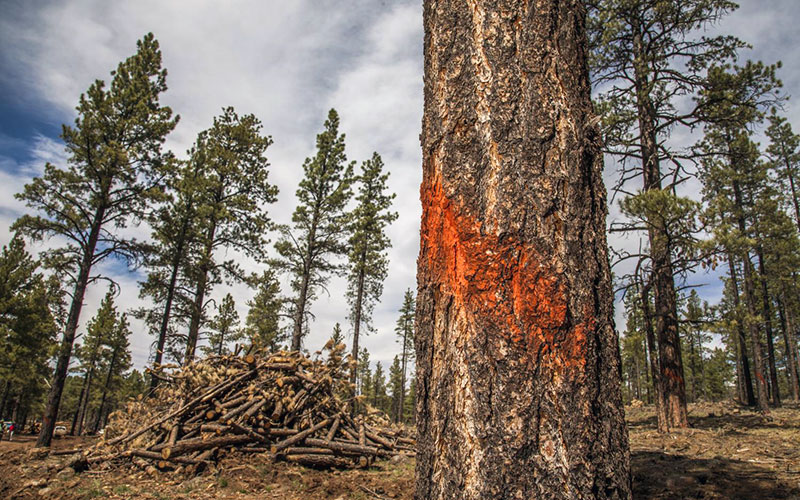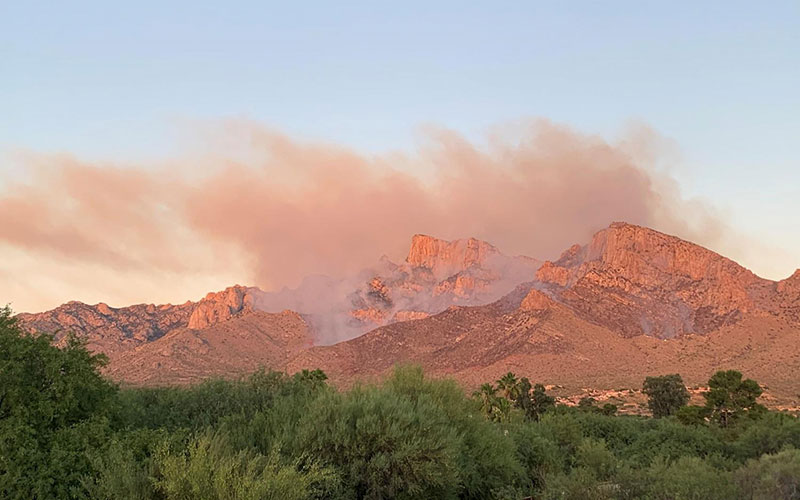
Researchers say one way to live with fire is to thin fuel. In the desert, that means brush and invasive grasses. In the high country, that means small diameter ponderosa pine. (Photo courtesy of Ericka Nortemann/The Nature Conservancy)

The Nature Conservancy has partnered with government and nongovernmental organizations on this forest-thinning project site south of Flagstaff. A feller-grabber machine is used for the selective thinning. (Photo courtesy of Ericka Nortemann/The Nature Conservancy)
Arizona has had a busy fire season this summer. Now, with many of the big fires out, communities are beginning to look at their wildfire risk.
And for many, that risk is high, according to the Arizona Department of Forestry and Fire Management, which last year did a wildfire risk assessment of more than 500 communities.
It found that about 85% of Arizona’s communities are at moderate to high risk for wildfire.
The wildland-urban interface grows as more people move to the West. The trick, conservationists say, is to learn how to live with fire.
Researchers say that one way to do this is to thin fuel.
In the desert, that means brush and invasive grasses, such as buffelgrass, fountain grass and red brome. In the high country, that means ponderosa pine.
“Two hundred years ago, there were fires every three to five years in the ponderosa pine,” said Rob Marshall of the Nature Conservancy. “And they were surface fires. They were fires that were consuming the grass and burning the bottoms of trees where the bark is 4 inches thick and the trees can withstand it, and there were 20 trees per acre. Now, we have 200 to a thousand trees per acre, in our forests. They’re way too dense.”
He said fire can sometimes be used to thin the forest, but not in dense forests. Those fires burn too big and hot and turn into what’s known as catastrophic fire.
“But there’s only so many acres that you can apply fire to because there’s so many acres where there’s just too many trees, and you put fire in and it’s going to be catastrophic fire and you’re going to lose the forest, and so we’ve gotta get in there and thin the trees,” Marshall said.
Arizona has been battling this fuel buildup for decades on the local, state and federal level.
On the local level, Community Wildfire Protection Plans can help. Those programs outline a plan of action and can help secure funding for thinning projects. But not everyone gets the message. People move to Arizona to enjoy the state’s scenery. For some, that includes trees.
“Another thing that we have seen, is that when you have a lot of residents in an area that are new to the area, and they like their trees, it can be hard to communicate effectively the need for reducing fuels, because that’s part of what drew them to the area,” said Melanie Colavito of the Ecological Restoration Institute at Northern Arizona University.
Colavito said these programs require a lot of work on the local level, and persistence on the part of volunteers. There is evidence that Arizonans are beginning to understand the importance of thinning.
The state began an enormous thinning project after one of the largest wildfires in the state burned about half a million acres. The project, known as the Four Forests Restoration Initiative – 4Fri for short – operates in the Kaibab, Coconino, Tonto and Apache-Sitgreaves national forests.
There are two ways to thin the forest. One is to cut trees, the other to burn them. 4FRI wants to do both. But only fire has succeeded on a large scale. Since 2010, prescribed fire and managed wildfire have thinned about 600,000 acres of forest.
That’s the kind of grand scale that 4FRI envisioned. Mechanical thinning is behind schedule. That’s because there isn’t much of a market for small diameter trees that thinning targets.
“You have to do something with those trees,” Marshall said. “You can’t just cut ’em and stack ’em somewhere, right? So you’ve got to be able to process those trees.”
Henry Provencio of the Coconino National Forest said the state is getting closer to establishing those markets. He also said 4FRI has had some successes in restoring watersheds.
“There’s been a lot of springs restored,” he said. “Like I said, we’ve introduced fire back into the landscape in a lot of different areas.”
He hopes that future thinning efforts will be more successful as new proposals take shape.
“We’re still trying to crack that nut, on the mechanical treatment side, and I think we’ll get there as long as everybody continues to stay at the table, and is focused,” he said.
Colavito said preparation can make communities resilient when fires occur.
“There’s mounting evidence that communities around the United States and around the world must learn to live with fire,” she said. “In the western U.S., we’ve seen fires increase in size and severity over the past few decades, and this trend is definitely going to continue due to climate change.”
That’s why planning is so important.
“I think really with collaborative planning and preparation for these fires that are inevitable, can help to create communities that are fire adapted and resilient,” Colavito said.
